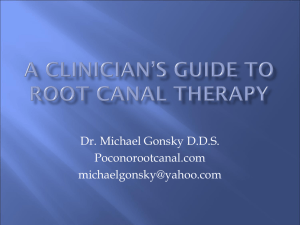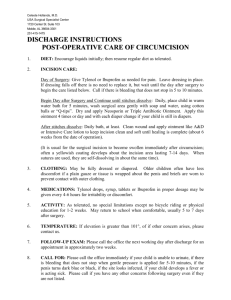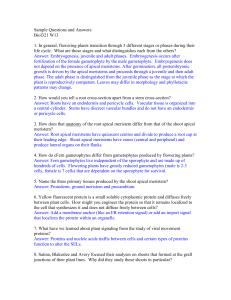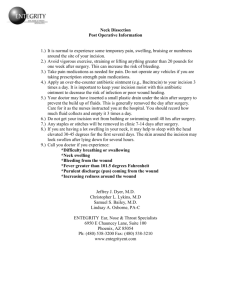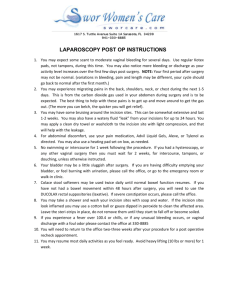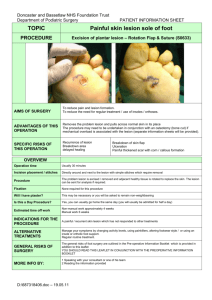File - Jude 2011-5th year - Home
advertisement
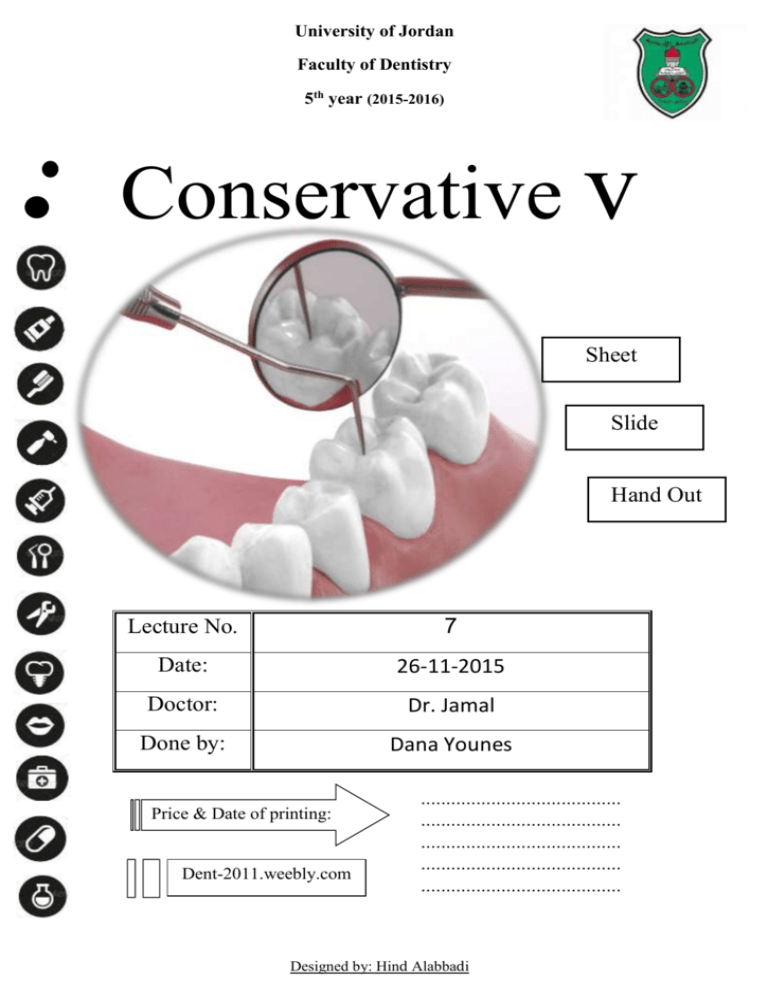
University of Jordan Faculty of Dentistry 5th year (2015-2016) Conservative v Sheet Slide Hand Out Lecture No. 7 Date: 26-11-2015 Doctor: Dr. Jamal Done by: Dana Younes Price & Date of printing: Dent-2011.weebly.com ........................................ ........................................ ........................................ ........................................ ........................................ ........................................ ......... Designed by: Hind Alabbadi Dana Younes Conservative #7 26-11-2015 Surgical Endodontics We usually start our endodontic treatment by conventional endodontics or non-surgical endodontics (which we do normally in the clinics), if it fails we go for conventional retreatment, if it fails we go for surgical endodontics (which is our second option after retreatment), if it fails then we extract the tooth and replace it by implants. Surgical endodontics is needed when: 1. Teeth have responded poorly to conventional treatment 2. Teeth have failed to respond to conventional retreatment Surgical endodontics is done either by endodontist or oral surgeon but most of the time it’s done by endodontist. Scopes of endodontic surgery: 1. Incision and drainage: mainly done when the patient has swelling, we don’t just put the patient on antibiotic and send him home, we have to do incision and drainage. So the emergency treatment for swelling is incision and drainage. 2. Apical curettage: cleaning the apical area from the apical lesion. 3. Apicectomy with retrograde filling 4. Hemisection and root amputation: Dana Younes Conservative #7 26-11-2015 5. Hemisection is cutting the molar into two pieces, while root amputation is removal of one of the roots and leave the other roots (remove the diseased root and keep the healthy ones). 6. Replantation: taking the tooth out from the socket, do whatever to be done and then put the tooth back into the socket. Indications: 1. Failure of conventional therapy obviously or apparently A. Obviously inadequate filling either short filling or overextended filling and the patient has symptoms. B. Adequate filling (apparently): filling is done perfectly 100% but there’s a failure, we don’t know from where the failure come. 2. Calcified canals: we can’t find the canals and the patient has symptoms 3. Procedural errors: A. Instruments fracture in the root: if we can’t take it out we do the root filling, send the patient home, after 2 weeks he will came back in pain then we do surgical endodontics. B. Over instrumentation or perforation C. Non-negotiable ledge D. Symptomatic overfilling 4. Presence of post in the canal and there’s a failure of RCT 5. Anatomic variations 6. Apical fracture 7. Apical cyst 8. Biopsy Dana Younes Conservative #7 26-11-2015 The doctor showed some cases: A case of endodontic failure with apical lesion, the RCT is poorly done and the retreatment is not going to work so we did apical surgery. We cut 2-3mm from the apex of the root in 45◦ and then we did a retrograde filling which is amalgam and after 1 year of follow up, the apical lesion has resolved. A case of a poorly done RCT that is 5mm short with post and crown, we can remove the post and the crown but if the patient choose the surgery we have to go for the surgery. So we must give the patient treatment options and then the patient choose what treatment he wants. If the patient likes the color of the crown, he’s living with the crown and doesn’t want to change it, then we go for apical surgery. A case of calcified canal where we did the access cavity and removed a lot from the tooth structure and we can’t find the canals and the patient has symptoms. If we have a calcified canals and the patient doesn’t have symptoms then we don’t have to treat but if the patient has symptoms then we have to treat the symptoms by apical surgery. A case of lower first molar with post in the mesial canal and another post in the distal canal, the crown is good with good Dana Younes Conservative #7 26-11-2015 margins but there’s a periapical lesion on mesial root and one on the distal root. What we did is surgical endodontics. A case of fractured instrument in mesiolingual and mesiobuccal roots with periapical lesions, we did the apical surgery with a retrograde filling and after 1 year follow up, the lesion resolved. A case of a root fracture in the apical third, it will easily be removed by apical surgery, the root and the crown will stay in a healthy situation. While fractures in the middle of the root can’t be fixed by apical surgery. In this case the tooth will be mobile and that mobility sometimes can be fixed sometimes not. Contraindications: 1. Should not be a cover up for lack of skills in non-surgical endodontics. 2. It’s not indicated because the lesion is present at time of treatment A case of a conventional endodontic treatment that is done before 6 months, the patient has no symptoms but there’s a periapical lesion on the radiograph, we don’t do surgery and we have to wait at least 24 months and sometimes it may take 5 years to heal (on the radiograph we have a lesion but the patient has no symptoms, we don’t have to treat, must wait until the lesion resolves). Studies have reported in literature that the lesion may take 1012 years to resolve. 3. It’s not necessarily indicated because a large lesion is present. Dana Younes Conservative #7 26-11-2015 4. Local anatomic factors: short root length, poor bone support 5. Poor systemic health: blood dyscrasias, neurological problems, uncontrolled diabetes, pregnancy. 6. Psychological impact: highly emotional or extremely apprehensive patients Surgery to very young or very old patients can be a psychic trauma as well. Types of flaps: 1. Semilunar flap: not used anymore because it has many disadvantages. 2. Single vertical or triangular flap: consist of a horizontal incision and one vertical incision in order to gain access to the tooth (used when we need small access). 3. Double vertical flap: consist of a horizontal incision and two vertical incisions, used when we need more access in long roots. 4. Scalloped flap: the flap of choice in majority of surgical cases, done first by horizontal incision 3mm above the gingiva (in attached gingiva, not in sulcular area) to prevent gingival recession after healing (the main advantage of scalloped flap). Procedure: 1. Do the incision with #15 blade start with the horizontal incision then the vertical incision. The incision should be started one tooth mesial and one tooth distal to the tooth we are working on in order to gain access. 2. Reflecting the flap. 3. Retracting the flap: Dana Younes Conservative #7 26-11-2015 Flap retraction is a passive or holding state of the reflected flap, it has to be on bone and must be within the size of the flap and the instrument tissue angle. 4. Expose the apical bone at the apical area, sometimes if there’s a large lesion (granuloma), upon reflecting the flap we can see the lesion, there will be no bone covering it. Sometimes we have to remove cortical bone (by osteotomy with low speed round bur). 5. After reaching the apical area we do curettage to remove the lesion and granulation tissue. Put the tissue in 10% formalin solution and send it to the lab to know what the lesion is (cyst, granuloma,…), we must do the pathologic examination in order to know the type of tissue that have been removed. 6. Cut 2-3mm from the apical area in 45◦ 7. Prepare a cavity in the apical area about 2-3mm in depth with the use of ultrasonic device (called retropreperation). 8. Put a retrograde filling (in conventional RCT we do orthograde filling). 9. Clean the area from the residual filling. 10. Put the flap back and close with sutures. Characteristics of ideal retrograde filling material: 1. As long time sealing capacity 2. Biocompatible 3. Non-resorbable 4. Easy to prepare and place 5. Can be seen on radiograph 6. Not affected by moisture Dana Younes Conservative #7 26-11-2015 Retrograde filling materials: 1. IRM 2. Super EBA 3. Amalgam 4. MTA Super EBA: Powder is 60% zinc oxide Liquid is eugenol and ethoxybenzoic acid (EBA) MTA: minimal trioxide aggregates Commercial name is pro-root Consist of Portland cement Very expensive material Uses: 1. Sealing of apical area 2. Pulp capping: near pulp exposure in young patients 3. Sealing of perforations: no long term success rate of this material that it’s best than other materials. Sealing of floor perforations will fail later on. Post-operative care: 1. Give ice pack for the rest of the day of the surgery 2. Pain killers and antibiotics for the first 5 days or 1 week 3. Remove the sutures after that Endodontic surgery to the anterior teeth is easier than to the posterior teeth which is very difficult. Dana Younes Conservative #7 26-11-2015 Healing of periapical lesion: Healing is either by regeneration of bone and apical periodontal ligaments or repair by scar tissue. Healing by repair: when we take a radiograph, there will be a radiographic lesion but the patient has no symptoms, we don’t need to do anything. Failure of endodontics treatment in upper first molars mostly in the mesiobuccal root because of missing the MB2 canal during treatment. Good luck
